Updated: 31st December 2023
Have you ever considered bike touring but feel held back because you only have a road bike? Or you want to use a road bike for all your commuting needs? Well, you’re already on the right track. Some people wait for the perfect gear, but starting with what you have is an excellent first step.
Can You Put Panniers On A Road Bike?
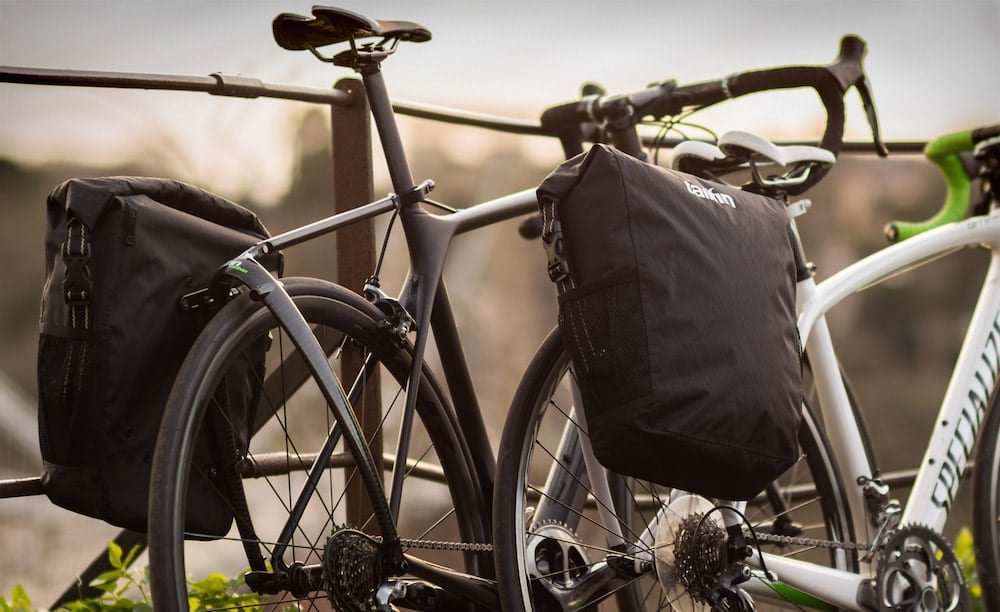
Yes, you absolutely can outfit a road bike with panniers.
Gone are the days when the lack of built-in eyelets on road bikes made it nearly impossible to attach racks.
Thanks to innovative solutions, this challenge is a thing of the past. There are specialized kits available now that cleverly allow the mounting of racks by shifting the weight onto the axle, which is inherently designed to handle heavier loads.
This means that even without traditional mounting points, you can securely fit panniers to your road bike.
Moreover, there are unique attachment systems, such as sturdy pucks and versatile seatpost collars, that facilitate the addition of panniers.
These advancements have significantly broadened the scope of what you can do with a road bike.
Whether it’s for daily commuting or embarking on extended touring adventures, these innovations enable your road bike to adapt without compromising its essential design and efficiency.
Mounting Racks On Your Road Bike

Mounting racks on road bikes can be a bit of a puzzle, especially when many models lack the necessary eyelets. While some entry-level Trek and Giant bikes offer the option to attach racks directly to the frame, others may not be as accommodating.
What if Your Bike Lacks Eyelets?

Don’t worry if your bike doesn’t have eyelets; there are ingenious solutions out there.
Old Man Mountain, for instance, has revolutionized the game with their Fit Kits. These kits cleverly transform any bike into a rack-ready mode of transport.
They smartly shift the weight from the frame to the axle, a bike part inherently designed for heavy lifting. This feature is a game-changer, especially for road bikes and others lacking traditional rack eyelets.
For bikes without upper eyelets, Old Man Mountain has designed unique pucks that attach securely to the frame with ultra-durable zip ties.
Plus, they offer a seatpost collar with extra mounting points, widening the scope of bikes that can carry expedition racks. This means you no longer have to compromise your choice of bike for your adventures.
DIY and Alternative Mounting Solutions
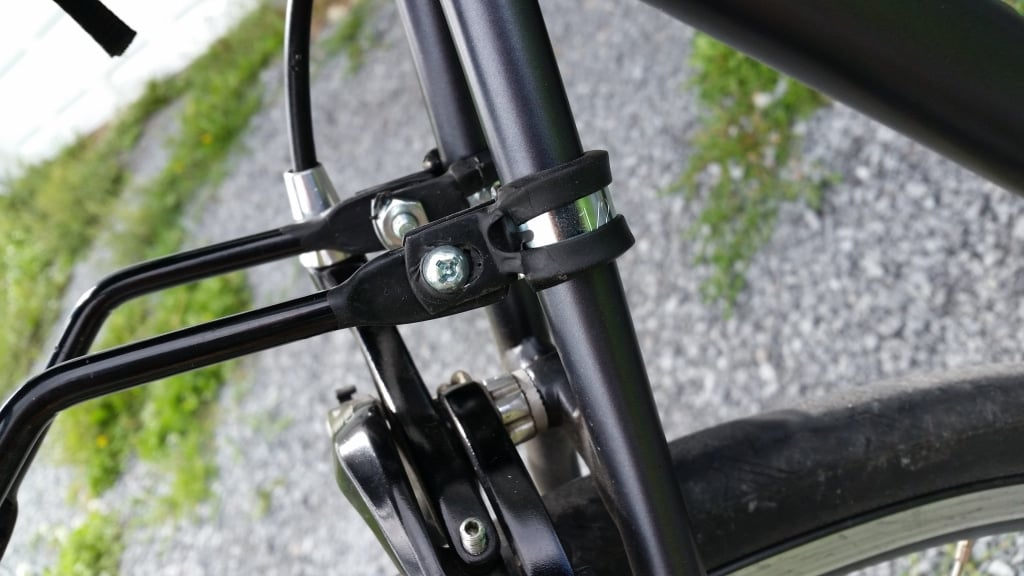
If you’re up for a bit of DIY, there are several alternative solutions to consider:
- P-Clamps: These cushioned metal loop straps can be a handy alternative for mounting a rear rack on bikes without eyelets. Affordable and easy to use, P-Clamps are available in various sizes at most hardware stores. Installation is straightforward – just open the clamp, place it over the fork blade or seat stay, and tighten with a bolt. They’re reliable and won’t slip.
- Tubus Stay Mounting Clamps: These are similar to P-Clamps but are specifically designed for attaching Tubus Racks to bikes without eyelets.
- Seatpost Clamps with Rack Eyelets: Some racks are made to fit road bikes using a seatpost clamp that comes with rack eyelets. This is an okay option for bikes that don’t have standard eyelets. These are what I used but don’t think I would recommend them.
- Quick Release Rack Mounting Kit: Ideal for bikes lacking lower eyelets. This kit allows you to mount the rack using a quick-release design, adding flexibility and convenience to your setup.
Racks for Road Bikes

When it comes to adding racks to a road bike, the choices can significantly impact your touring experience.
I recall my first bike tour, where I opted for a seat-post mounted rack on my road bike. From this experience, I learned that while this setup is feasible, it has its drawbacks.
The primary concern is the added stress on the seat post, especially under substantial weight. This not only poses a risk to your bike’s integrity but can also affect handling, making it more cumbersome compared to a traditional rear rack on a touring bike.
The combination of a high-mounted rack, the weight it carries, and the naturally light frame of a road bike can create a somewhat unstable ride.
For these reasons, I would be cautious in recommending a seat-post mounted rack for long-term touring setups.
For those seeking a more reliable solution, especially for road bikes without eyelets, the market offers some innovative options.
Companies like Old Man Mountain are at the forefront, providing versatile expedition racks that cater to all types of bikes.
Their racks, when paired with their Fit Kits, ensure that you can equip any road bike with a rack. This combination offers a more stable and sustainable solution for bike touring, ensuring that your road bike is ready for adventure without compromising on safety or handling.
Old Man Mountain Divide Rack
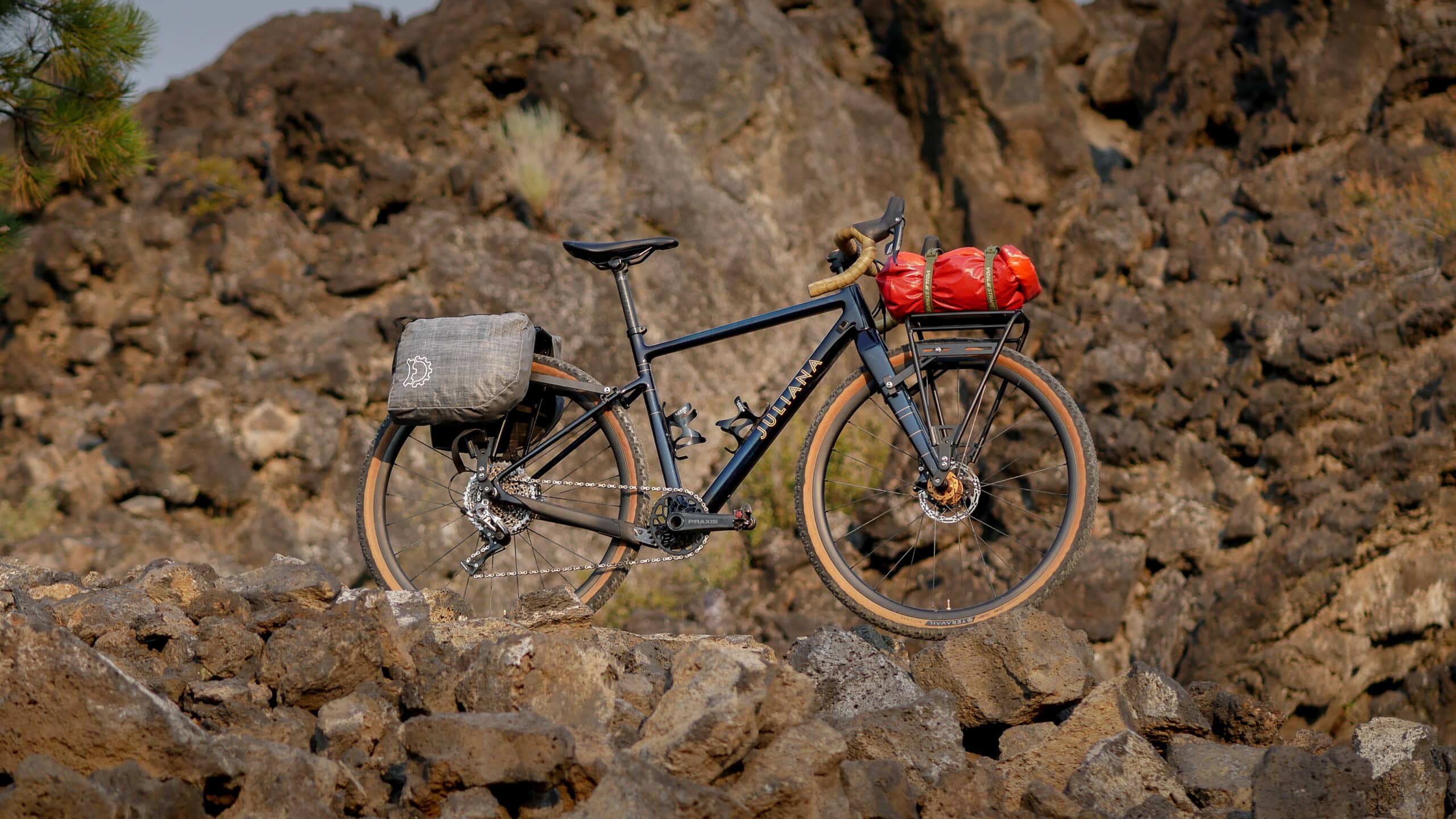
What makes the Divide Rack particularly suitable for road bikes is its innovative Fit Kit system. These kits enable the rack to be axle-mounted, making it compatible with nearly any bike, including those without traditional rack mounts.
This feature not only protects your bike frame from being overloaded but also enhances the rack’s stiffness and increases its weight capacity to an impressive 70lbs.
Additionally, the low pannier rail design is a game-changer. It not only simplifies access to gear on the deck without having to remove your panniers but also improves the bike’s handling by lowering the center of gravity.
Whether you’re packing for a week-long adventure or just carrying essentials, the Old Man Mountain Divide Rack adapts to your needs, making it a top choice for road bikers looking to expand their horizons without changing their ride.
Tailfin Racks

Tailfin’s range of pannier racks for road bikes includes both carbon and alloy options, catering to different riding styles like bikepacking, commuting, and touring.
Their carbon racks are lightweight and available with or without pannier mounts, starting at 257g. The alloy racks, slightly heavier, start from 409g.
These racks are designed for durability and versatility, accommodating various bag types and sizes.
Tailfin emphasizes innovation in its products, offering a combination of performance, convenience, and style for cyclists. For more details, you can visit their website here
Can You Tour On A Road Bike?
The short answer: Yes, it’s definitely possible to use your road bike for touring. You can even mount panniers, regardless of whether your frame has eyelets for a rack.
Let’s face it – nearly any bike can spark an adventure. I love this mindset because it makes bicycle travel accessible to everyone. It’s simple, and there’s no need to overcomplicate it.
However, I understand the challenges of beginning this journey. Using “whatever bike you have” is a great way to dive into your first cycling escapades, just like I did.
My first bike tour was on a road bike, specifically a Giant Defy 3 (2014), and it was far from ideal for a multi-day journey.
The setup was modest, featuring a seat post rear rack and inexpensive panniers purchased from eBay. Though it wasn’t the most enjoyable tour, it was a valuable learning experience.
This proves that touring on a road bike is possible, but there are lessons to be learned.
However, the experience was less than stellar. My gear, comprising low-quality seatpost clamps and cheap panniers, fell apart by the second day, leading to a series of makeshift zip-tie repairs.
If your plan includes a fully-loaded tour with multiple panniers and camping gear, a road bike might not be the best choice.
Road bikes aren’t designed to handle such extra weight. The frame and wheels can struggle under the added load, potentially leading to mechanical issues.
If you’re aiming for a lighter bicycle touring adventure, a road bike could suffice. But for more ambitious trips, like touring around the country or the world, investing in a dedicated touring bike is a wiser decision.
In 2015, I ventured into the mountains near Toora, VIC, with this setup. While it wasn’t the most fun tour, the experience was invaluable.
My key takeaway? Touring on a road bike is doable, but learning from my mistakes can significantly improve your experience.
Touring Bikes vs Road Bikes

Road bikes, known for their speed and agility, contrast sharply with the robustness and comfort of touring bikes, which are built for the long haul with heavy loads. To help you better understand these differences and choose the right bike for your adventures, we’ve put together a comprehensive comparison. For a deeper dive into the nuances of these two types of bikes, check out our detailed article here.
| Feature | Touring Bike | Road Bike |
|---|---|---|
| Purpose | Built for strength, comfort, stability; suitable for carrying heavy loads for long durations. | Designed for lightweight, speed, and stiffness; ideal for smooth surfaces, racing, and day rides. |
| Frame Material | Typically steel, offering more comfort due to its cushioning effect on body contact points. | Usually aluminium or carbon, not designed for hauling extra weight. |
| Load Carrying Capacity | Designed to withstand significant loads; equipped with attachment points for front and rear racks, and extra water bottles. | Not typically designed for carrying heavy loads; lacks extra attachment points. |
| Comfort and Stability | More comfortable and stable, especially under heavy loads, due to frame construction and geometry. | Less stable under heavy loads due to lighter construction. |
| Handlebars | Offers various types like trekking/butterfly handlebars for different hand positions. | Standard drop bars, focused on speed and aerodynamics. |
| Tires | Varies depending on the type of touring; generally thicker than road bike tires, offering more puncture resistance. | Typically thin (around 23 mm), designed for speed and less resistance on smooth surfaces. |
| Geometry | Longer wheelbase for stability, more upright riding posture, longer chainstays for pannier clearance. | Shorter wheelbase for responsive feel, aggressive riding position for speed and aerodynamics. |
| Saddle | Generally more comfortable, suited for long rides. | Focused on lightweight and performance, may be less comfortable over long distances. |
| Gearing | Lower gearing to facilitate easier riding on uphill terrain with a loaded bike. | Geared for speed and efficiency on flat or rolling terrain. |
How to make your road bike touring experience better
Mastering Even Weight Distribution

A key to successful bike touring, especially on a road bike, is achieving even weight distribution.
This is crucial not only for handling but also for the longevity of your bike. Concentrating too much weight at the rear can lead to accelerated wear of the back tires and increase the likelihood of flats.
To counter this, consider using front panniers, a frame bag, top tube bags, and handlebar bags. Distributing your gear across these different areas helps balance the load between the front, middle, and rear of your bike.
While it might feel unfamiliar at first, with a bit of practice, you’ll quickly adapt to this more balanced setup.
Opting for Smaller Panniers or Bikepacking Bags
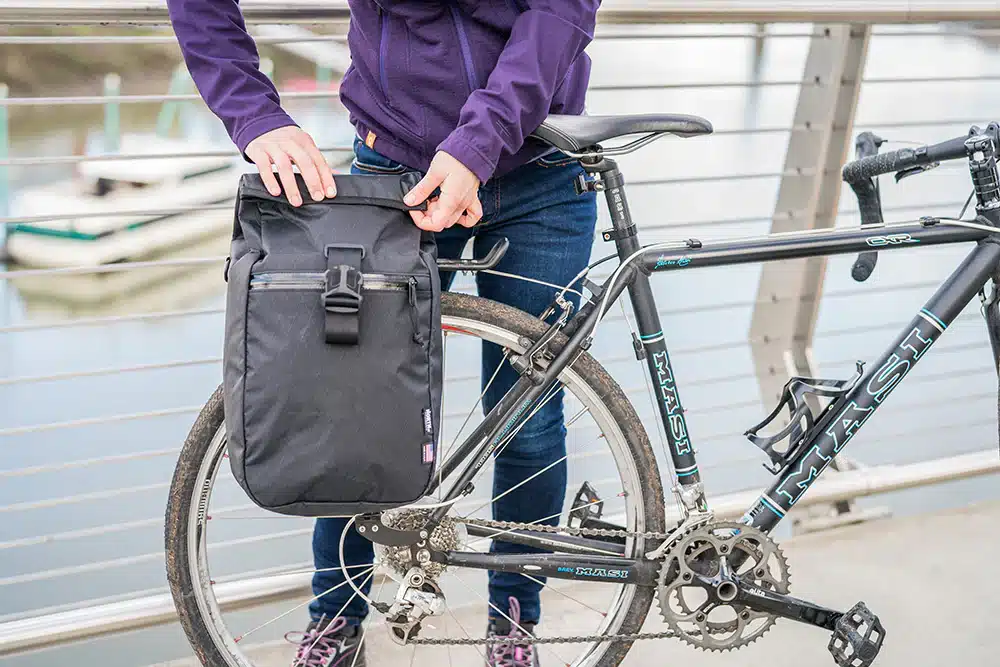
Another effective strategy is to use micro panniers or bikepacking bags. Micro panniers are smaller than traditional touring panniers and provide extra clearance, which is particularly useful given the shorter chainstay length of road bikes.
This helps to prevent heel strike – a common issue when larger panniers are used on bikes with shorter chainstays.
Alternatively, bikepacking bags are an excellent choice for a more integrated approach to weight distribution.
These bags are designed to attach directly to various parts of the bike frame, distributing weight more evenly and reducing the concentration of load at the front and rear.
This setup not only improves bike handling but also streamlines your ride, making it more agile and suited for road bike touring.
Lightweight Packing
Be mindful of the total weight you’re carrying. Opt for lightweight, compact camping gear and clothing. The lighter your load, the less strain on both the bike and the rider.
Turning a road bike into a touring bike
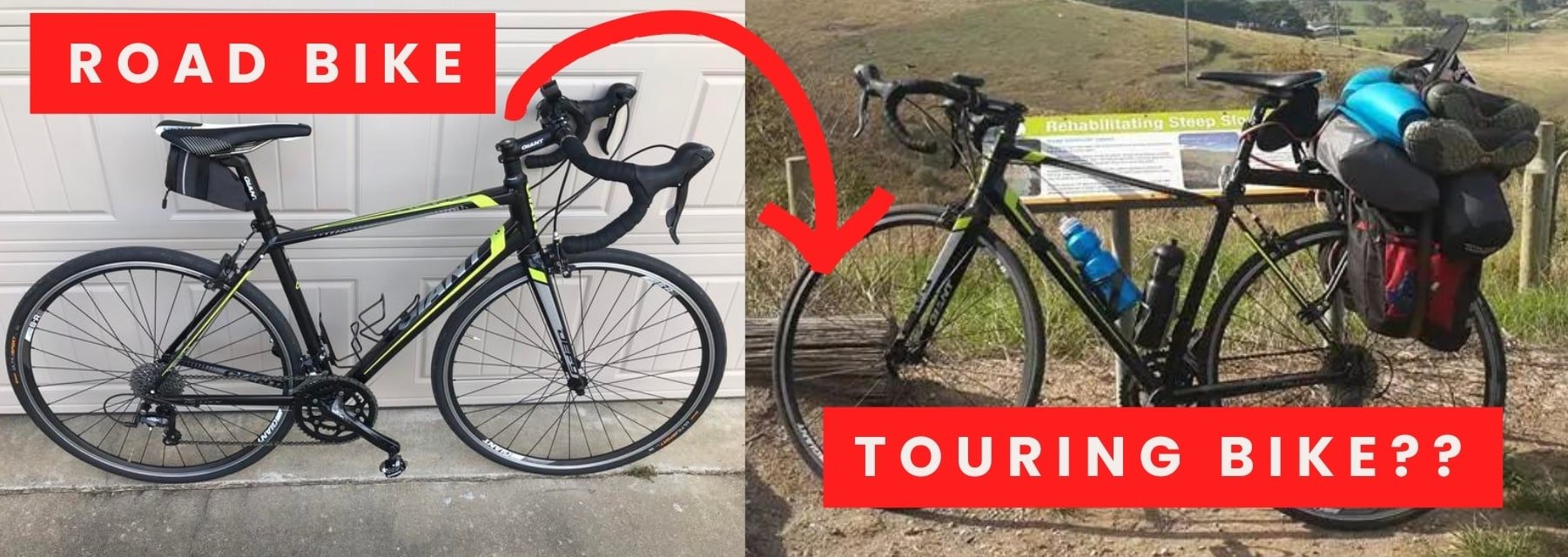
Embarking on a touring adventure doesn’t always mean you need a specialized bike.
Converting your road bike into a touring bike is an option and you can get so far by changing components and parts to optimize for improved comfort.
Just enough to get by, like I did in those early days.
It’s worth considering that if you’re going to great lengths to modify and optimize your road bike for comfort and adventure, investing in a touring bike might be a more practical solution.
There are even more budget-friendly options to get you started.
There are several fantastic touring bikes available for under $1,000.
These bikes are specifically designed for the rigors of touring, offering built-in features for comfort, durability, and weight distribution that a road bike may lack.
This route could save you time and effort in the long run, ensuring you have a bike that’s ready for adventure right from the start
Upgrade Your Tires
Switch to wider, more durable tires if your road bike frame allows. Wider tires can handle varied terrains better and are more resistant to punctures, which is crucial when carrying extra weight. Look for tires with good grip and puncture-resistant layers.
Adjust Your Gearing
Road bikes typically have higher gearing suited for speed. Consider modifying your bike’s gearing for a more touring-friendly setup, especially if you’ll encounter hills. Lower gears can make pedaling with a heavy load much more manageable.
Ergonomic Seating
Long hours in the saddle demand comfort. If your road bike has a racing saddle, think about swapping it for a more comfortable one. A seat with better padding can reduce fatigue and discomfort on longer rides.
Handlebar Modifications
Consider adding bar ends or changing your handlebars for added comfort. Alternative handlebars or extensions offer more hand positions, reducing the risk of numbness or strain during long rides.
Why you shouldn’t tour on a road bike

Unsuitable geometry
The geometry of a typical road bike is not crafted with the requirements of touring in mind.
One of the critical aspects of a road bike’s design is its stack/reach ratios. These ratios position the rider in a forward-leaning, aerodynamic posture, optimized for speed and efficiency. Touring, on the other hand, demands a more upright position for enhanced comfort during long rides. This difference in riding posture is a fundamental mismatch for road bikes when used for touring.
Furthermore, the chainstay length in road bikes typically ranges from 405 to 415 mm, shorter than that of a standard touring bike, which is around 435 to 450 mm or more.
Touring bikes are designed to accommodate rear pannier setups, providing extra room and avoiding the common issue of heel striking the panniers while pedaling.
If you’re experiencing heel clearance problems on a road bike, it might be due to oversized panniers or the inherently short chainstay.
One workaround is opting for micro panniers, which are designed for smaller clearance spaces.
The wheelbase of a bike also plays a crucial role. Road bikes usually have a shorter wheelbase, leading to instability when fully loaded with gear. In contrast, a longer wheelbase in touring bikes offers a more grounded feel and better stability under load.
Another geometry consideration is the trail length. Road bikes are designed with a shorter trail for quick and responsive cornering – a feature that is less desirable in touring bikes. When carrying a load, especially at the front, a longer trail is preferable for precise control, better maneuverability, and stable cornering.
Discomfort over Long Distances
As I mentioned in the geometry section. Road bikes are optimized for performance and speed over short to medium distances. The aggressive riding position and stiffer frame can lead to discomfort over long touring distances, potentially causing strain on the back, neck, and wrists.
Inadequate Wheel Strength
Road bikes typically have wheels with fewer spokes and lighter rims, which might not withstand the additional weight and stress of touring gear. Touring bikes, on the other hand, are equipped with stronger wheels that can handle the extra load without compromising reliability.
Inadequate Gearing for Heavy Loads
Road bikes are equipped with higher gear ratios that are great for speed on flat surfaces but can become a challenge when climbing hills, especially with a heavy load. Touring bikes typically have lower gear ratios, making it easier to pedal with heavy gear over varied terrains, including steep inclines.
Frame Strength and Material
Road bikes are built for speed, not for bearing weight. Their frames, often made of lightweight materials like carbon fiber or thin aluminum, can be more susceptible to damage under the heavy loads of touring gear. Touring bikes, in contrast, are usually made of more robust materials like steel, which can handle the stress of extra weight without compromising the bike’s integrity.
Embrace Bikepacking Instead
If you’re considering the volume of gear you need for your trip, bikepacking might be the perfect solution. I’m increasingly leaning towards this style of bike travel, as it offers a lightweight and streamlined alternative to traditional bike luggage.
However, it does require investing in quality bike bags such as a large saddle pack, frame bag, top tube bags, stem bags, and a handlebar bag.
Bikepacking not only simplifies your load but also enhances your mobility and connection with the journey.
Speed and Comfort: Achieving the Best of Both Worlds
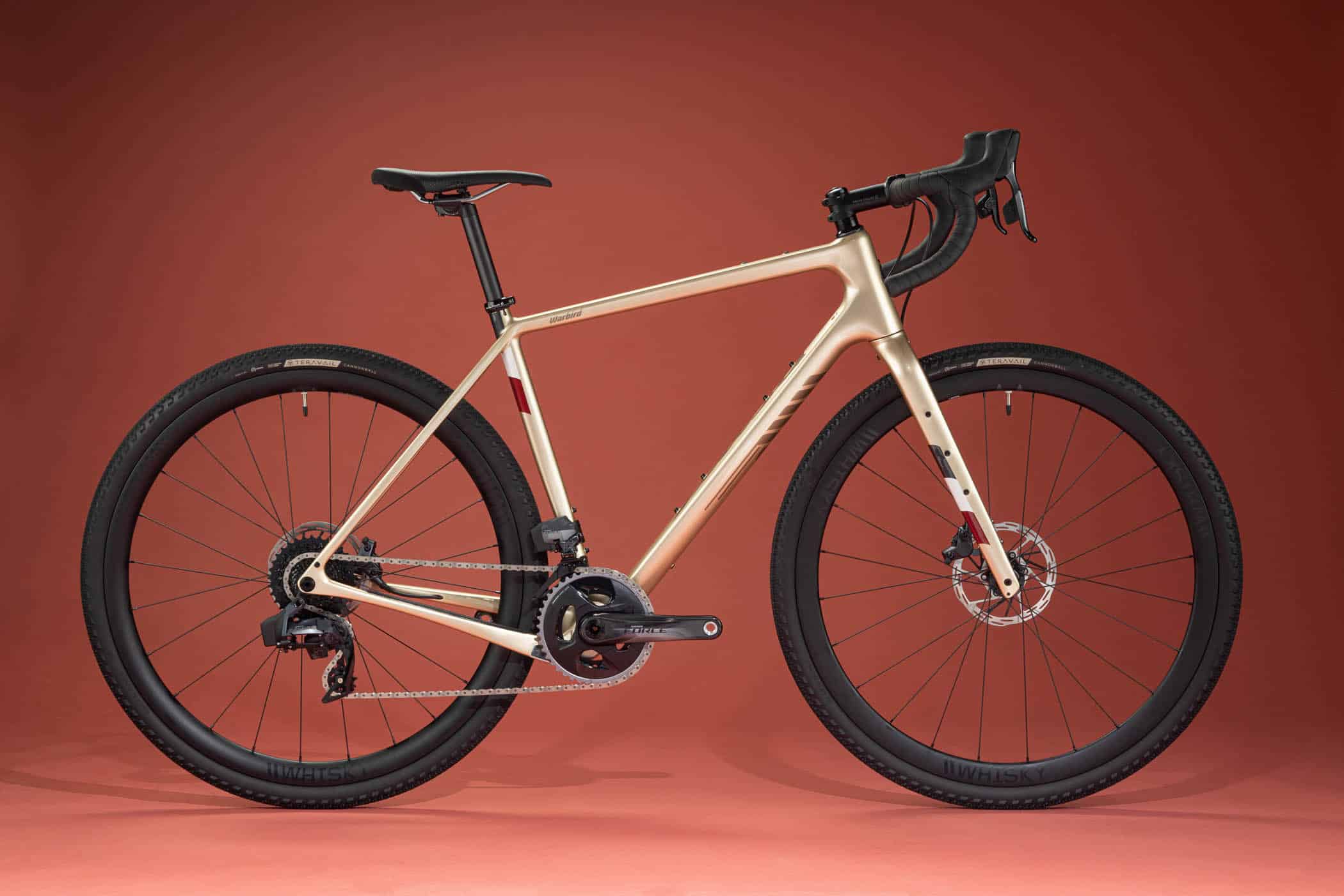
Perhaps the reason you’re contemplating touring on a road bike is that it’s what you already own, and you’re eager to maximize its potential. If that’s the case, absolutely embark on that trip and make the best of it.
But be forewarned, touring on a road bike can add extra layers of challenge to your adventure.
If your goal is to combine speed with a reasonable level of comfort, consider exploring the world of fast-racing gravel bikes.
These bikes are designed to blur the lines between on-road efficiency and off-road resilience, offering a balance of speed and comfort.
Some models even venture beyond the beaten path, opening up a world of adventure possibilities.
Gravel Bikes For Touring

Then there’s the realm of gravel bikes tailored more towards touring. These models prioritize comfort and the thrill of exploration over sheer speed.
The market is abundant with gravel bike options, each catering to different adventure needs.
That’s why I’m dedicated to compiling a resource to help you find your ideal adventure bike.
I’ll also include further readings and insights into bikes that are particularly noteworthy for their touring capabilities, assisting you in making an informed decision for your next big adventure.

